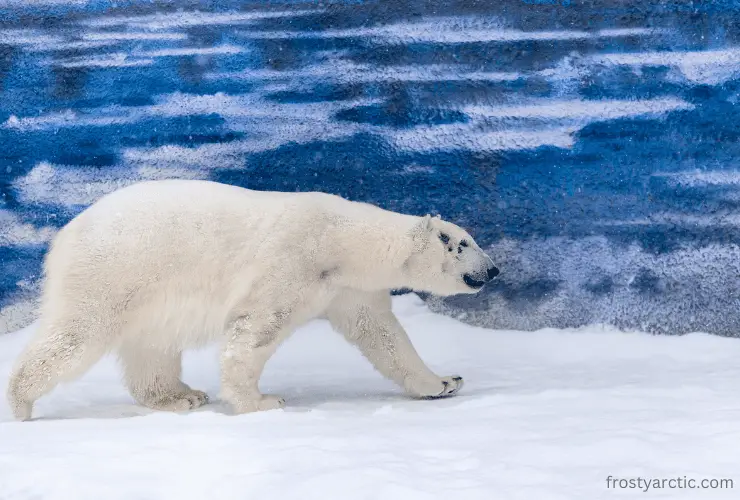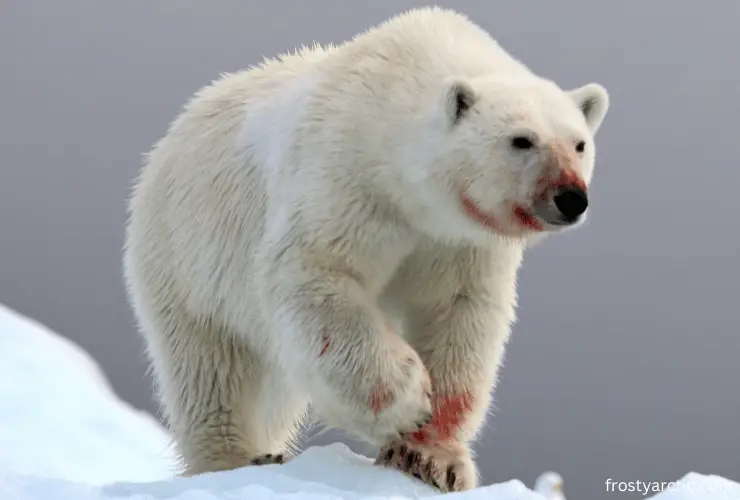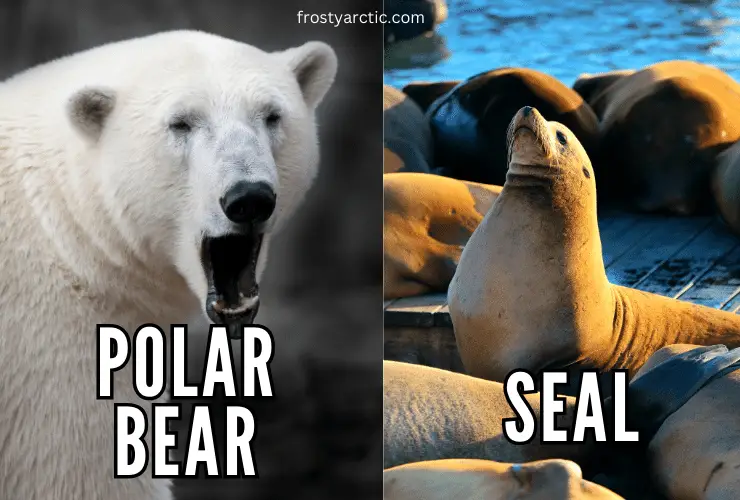Polar bears eat seals. In fact, seals are the main prey of polar bears, unlike other bear species. There are more than 30 species of seals, but polar bears like to eat ringed seals, bearded seals, harp seals, harbor seals, and hooded seals. Moreover, they are excellent hunters of seals, especially on the ice.
Did you know how polar bears find seals? Do they use their sense of smell or intelligence to detect the seals from miles away? Just get ready to explore the delectable world of the seal-sational diet of polar bears. We hope this research-based article has answers to all of your queries.
Read on to find out the truth!
Are Seals the Primary Diet of Polar Bears?
Yes! Seals are the primary diet of polar bears. These cuddly creatures make up a significant portion of the diet of polar bears. Moreover, seals are a critical and abundant food source for polar bears.
According to the report of the WWF Arctic Program, if a seal weighs 121 pounds, it can give energy for a couple of days, approximately 8 days. Still, polar bears eat more to store extra fat. Did you know this fact before?
What Species of Seals do Polar Bears Eat?

According to the research of the WWF Arctic Program, polar bears primarily prey on all species of seals. But they prefer to eat certain special species of seals in the Arctic. Here is a quick stats table that states what seal species polar bears prefer to eat:
| Seal Species | Scientific Name | Description |
| Ringed Seals | Pusa hispida | Ringed seals are the primary prey of polar bears. These species of seals are abundantly available in the Arctic tundra. Ringed seals are the most energy-rich prey. Cubs and mother polar bears mostly eat ringed polar bears. |
| Bearded Seals | Erignathus barbatus | Bearded seals are another important prey of polar bears. These seal species have moderate population levels in the Arctic. If ringed seals are not available, then polar bears hunt and eat bearded seals. |
| Harp Seals | Pagophilus groenlandicus | Harp seals are occasional prey of polar bears. The population of these species of seals fluctuates, they are sometimes rarely available and sometimes abundantly available in the Arctic regions. |
| Hooded Seals | Cystophora cristata | Polar bears rarely eat hooded seals. The exact population status of these species of seals is still unknown. |
| Ribbon Seals | Histriophoca fasciata | Similar to hooded seals, ribbon Seals are also rarely hunted by polar bears. Their population status is also still unknown. These are the uncommon prey of polar bears. |
According to the study by Polar Bears Facts Net, Spotted seals are also living in the Arctic and polar bears hunt them. Also, polar bears living in the areas of Greenland, North America, and Svalbard love to eat harbor seals.
Important Note
The relationship between polar bears and these seals involves predation patterns. Polar bears primarily rely on ringed seals and bearded seals as their main food source. The other seal species are secondary or occasional prey for polar bears, depending on the region and availability.
How Do Polar Bears Hunt Seals?
Seals are challenging to catch, but polar bears are expert hunters. Polar bears use the following methods to hunt seals: ~ Source
- Don’t Move Strategy: All polar bears use a special method of hunting seals – “Don’t Move”. They wait patientlyt for the sealy near their ice holes. Whenever they sense that a seal is surfacing, they attack them instantly and kill them. Finally, eat them!
Note: Seals are semi-aquatic animals, and they dig 10 to 12 ice holes to come out of water again and again. They come out of the water after 15 to 20 minutes to breathe after staying in the water. Ice cracks also serve as a breathing spot for them. Polar bears do not miss these opportunities and hunt them easily. So, this was the complete story!
- Smell It Well: Polar bears have a strong sense of smell. They can easily find the birth lairs of seals using their sensitive sense of smell. Once it identifies the lair, the bear skillfully breaks through the roof to catch its prey. This hunting strategy also showcases the extraordinary hunting abilities of polar bears.
- Camouflage Strategy: Polar bears often use this strategy. Their fur is transparent, and it appears white in the Arctic environment. They hide themselves in the snow and ice. In this way, they ambush their prey.
- Haul-Out Hunting: In warmer months, polar bears hunt seals that haul out on rocks or land. They cautiously approach these areas. Polar bears are good at exploiting the seals’ limited escape routes.
Apart from the above-mentioned methods, polar bears also break into the dens of seal pups in order to hunt them. They may also stalk the seals to catch them and run after them. Also, polar bears swim in the water to catch them from within the water.
Fun Facts Time
According to the National Wildlife Federation, polar bears are so strong that a seal cannot stand in front of them. A polar bear can hunt a seal with one paw swipe. Then, it bites and kills the seal. Arctic bears use sharp paws and claws, strong teeth, and big bodies to catch an adult seal without wasting energy. Polar bears always win battles with seals!
Do Polar Bears Hunt Seals in Groups?
No, polar bears do not hunt seals in groups. The reason behind this hunting behavior is their territorial behavior. In fact, polar bears are solitary hunters. Every polar bear is well-equipped to hunt individually.
However, you can see them together occasionally in certain situations. For instance, during mating or while a mother is taking care of her cubs. But even in these cases, they do not actively hunt together as a coordinated group. Thus, we can say that each polar bear hunts and survives on its own.
Here is a documentary from the BBC Earth channel on YouTube.
This video clearly shows how polar bears are ambushing the colony of seals. They are sharing their hunted prey but they are not doing teamwork like other carnivores do. They are not hunting in groups or teams.
Why Do Polar Bears Feed on Seals?
Alex Cooper, one of our Quora colleagues and an animal lover, claims that polar bears consume seals to obtain the highest levels of fats and proteins. He gives many other reasons why they feed on seals. Some of them include the following: ~ Source
- Carnivorous: We know that polar bears are carnivorous. And, great wildebeest migration does not move towards the Arctic. So, polar bears rely on only fiesta – Seals. Seals give them the meat that is enough to survive in the harsh temperatures of the Arctic.
- Live Longer: Polar bears eat seals to live longer. There are vegan and omnivore bear species too, but they do not live longer as compared to polar bears.
- Unmatched Fights: There is no matching fight between polar bears and seals. This is because seals cannot fight back against polar bears due to many reasons. They don’t have any strategy for withstanding bears. So, polar bears hunt them ruthlessly.
- Fat Wrappers: Blubber and fats can be called fat wrappers around the seals. They are a complete package of blubber for polar bears. That’s why polar bears feed on the thick coat of blubber on seals. Sometimes, polar bears do not eat their meat (muscular red meat) and solely feed on their blubber and fats.
- No Other Option: Polar bears do not have any other option instead of feeding on various seal species in the Arctic. They have secondary prey options in the summer because seals are not abundantly available. But, in winter, they totally rely on seals. Other mammals are scarcely available in winter for polar bears. What if other options are available? They are not suitable for polar bears in winter.
- Thermoregulation: This is one of the main reasons why polar bears feed on seals. The thick layer of blubber in seals aids in thermoregulation for polar bears. It helps them maintain their body temperature in the freezing Arctic waters.
Apart from the above-mentioned reasons, polar bears must hunt seals. The co-evolution of predator and prey is essential for a balanced ecosystem. Lastly, polar bears hunt seals because they are too lazy to hunt other big animals on land like deer, reindeer, wild buffalos, and so on.
They do not want to waste their energy on speedy and sharp land mammals, and they are not good swimmers either. So, they sit and wait for seals. Simple! Here is an amazing video footage of when a hungry polar bear hunts a ringed seal. Enjoy!
Do Polar Bears Eat Seal Pups?
Yes. Polar bears eat seal pups. The comprehensive study on Polar Bears Facts also states that polar bears love to consume pups of seals. They target pups and young seals instead of old and sick seals. According to the report:
“The maximum weight of an adult hooded seal is 600 pounds. So, it’s a challenging task for polar bears to hunt them. But they hunt hooded seal pups instead of young ones. Mostly, the pups of all species of seals lounge on the beaches and land for many weeks.”
Seal pups, especially those of species like ringed seals and bearded seals, are vulnerable. Their pups serve as an important food source for polar bears during certain times of the year. In the spring and early summer, seals give birth to their pups on the sea ice or in snow lairs. The lairs make them accessible to polar bears as they emerge from the birthing lairs just by following them.
How Many Seals Do Polar Bears Eat?

According to the estimate of Polar Bears Facts, the polar bear’s more than 90 percent diet is seals. The study further states:
“The entire population of polar bears living in the Arctic and Sub-Arctic regions consumes approximately one million (equals to 10 lac seals) seals annually. That’s a lot of seals!”
According to another study, one polar bear feeds on 30 to 50 seals per year. Furthermore, the number of seals a polar bear consumes per year is dependent on the season, size of seals, availability of seals, and also the size of polar bears.
How Many Seals Can a Polar Bear Eat in A Day?
On average, a polar bear can eat one to two seals in a day. Remember, this number is an estimate, and it fluctuates. This is because an adult polar bear can consume 1 to 18 kilograms of meat and fat.
A polar bear will not consume much if seals are abundantly available, and their tummy and appetite are full. Let’s take an example. If a polar bear successfully hunts a larger seal or a group of seal pups, it may provide enough food to sustain the bear for several days.
Plus, it is dependent on the weight of the seal. An individual polar bear cannot consume larger-sized seals. If the weight of the seal is 1 to 15 kilograms, then a single polar bear can eat it in a day. However, if it’s above 15 kilograms then two or more polar bears enjoy the seal party together.
How Do Seals Avoid Polar Bears?
Seals have many ways to stay away from dangerous and killer enemies like polar bears. Let’s discuss a few of them:
1. Spend Time in Water
The Wilderness Classroom organization explains the avoidance strategies of seals very well. It states that seals spend most of their time in the water or under the sea ice. This is their best way to avoid polar bears.
2. Blow Bubbles
Whenever seals feel the need to come out of the water, they blow bubbles. These bubbles give them a clue that it’s safe outside the water. Then, they come out of the breathing holes. But this is not where their survival story ends.
3. Dig Out Caves and Breathing Holes
Seals dig holes and caves in the ice and snow. These caves also have water and oxygen. In this way, these caves work out as blessed breathing holes for them where no polar bears are waiting for them. They come into these caves, rest, and breathe.
Pup’s Birth in Caves
Mother seals/female seals give birth to their only pup in these caves. It is safe for their pups because polar bears will never catch them in caves. They save their pups by staying with them for around 2 months.
How Long Does a Seal Last for A Polar Bear?

In the journal “Science“, a study states that the metabolism of polar bears is much higher than our imagination. An adult polar bear needs 15 to 19 pups for one week, or 12 days. These seals will be enough for polar bears to easily survive for 8 to 12 days.
If pups are not available, then polar bears require an adult ringed seal to survive for one week. It shows that a seal lasts for a few days to a maximum of one week or 12 days. The larger seals will last longer, while the smaller seals or pups may provide a meal for a day or two. ~ Source
Is Eating Seals Healthy for Polar Bears? Do Seals Carry Diseases?
Yes, eating seals for polar bears is healthy. There is no doubt behind this fact. However, some seals also carry diseases like pathogens, similar to many other wild animals. The SeaWorld organization states that polar bears mostly get Parasitic Roundworm Trichinella disease from infected and sick seals. They also carry some serious diseases. But polar bears can handle these risks.
The immune system of polar bears is so strong that they can handle various infections and diseases. In general, and throughout recorded history, disease transmission between polar bears and seals has not been a major concern. The seal’s disease does not significantly impact the health of the polar bear population.
What Can Stop Polar Bears from Hunting Seals?
Nothing. This is the correct answer! Nothing can stop polar bears from hunting seals. Their native region is the Arctic, where they are the dominant predators. They’ll die if they do not eat something. So, if one way doesn’t work, these Arctic beasts will try other ways to get some food.
And seals are at the top of their menu! Joe, one of the best writers on Quora Digest also states the same answer that polar bears cannot be stopped from hunting seals. However, the AMNH organization has mentioned “Global Warming”. It states that the melting ice due to global warming is somehow stopping polar bears from hunting.
Also, it’ll be the major reason that polar bears will shift their diet plan and stop feeding on seals in the future. It will also affect the ecosystem due to declining and inclining populations of polar bears, seals, and many other animals.
FAQs
Is a seal faster than a polar bear?
Yes, but in the water. Seals are faster in the water than polar bears. The speed of seals in the water is 14 to 25 miles per hour, while the speed of polar bears in the water is 10 miles per hour. Thus, seals will win the race and swim faster in the water. On the other hand, polar bears are faster than seals on land.
The speed of polar bears on land is 25 to 30 miles per hour, while the speed of seals is approximately 2 miles per hour. Also, seals look awkward while running or moving on land. So, we can say that polar bears run faster on land.
Is a seal bigger than a polar bear?
Yes, many species of seals are bigger than polar bears. For example, leopard seals and elephant seals are bigger than polar bears. A polar bear looks like a cute teddy bear in front of these seal species.
Do seals also hunt polar bears?
No, seals do not hunt polar bears. Seals are prey animals, not predators. These are polar bears that are called the top predators in the Arctic land. The relationship between polar bears is predator and prey. Polar bears are hunting, and seals are hunted. This is how their lives have been evolving for centuries.
When do polar bears hunt seals?
Although polar bears hunt seals throughout the year, the hunting period is also dependent on some special times. Mostly, polar bears hunt seals in November, June, and July. This is the time when seals are abundantly found, and their population is at a high rate in the Arctic tundra regions.
Do polar bear cubs eat seals?
No, polar bear cubs do not eat seals. They feed on their mother’s milk for a few months. Then, they start learning skills from their mothers and start hunting seals themselves. However, they are not fully independent until they are around two to three years old.
Are seals afraid of polar bears?
Yes. Seals are afraid of polar bears. In fact, they are fully aware of the danger they pose. Seals try to quickly flee into the water when they spot polar bears nearby. The hunting behavior of polar bears makes them vigilant and cautious to stay safe from them.
Conclusion
So, “polar bears eat seals” is a fascinating fact that gives us a valuable lesson about balance in nature. More importantly, the survival and reproductive success of polar bears are closely linked to seals. Thus, the abundance and availability of various seal species in the habitat of polar bears are crucial. If a polar bear eats only 50 seals from millions of seals, it is definitely not a big deal!
I hope you like the article. Thanks for reading and remember that there is a lot more to unfold!



4 thoughts on “Do Polar Bears Eat Seals?”